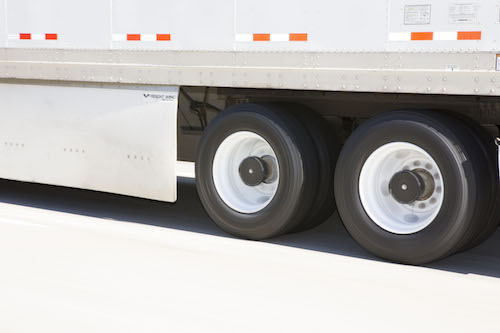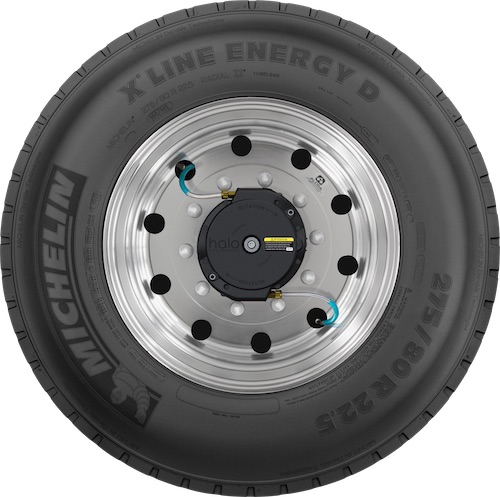Halo Tire Inflator Pumped Up by PLM

The Halo Tire Inflator’s simple design calls for an internal pump driven by wheel rotation to automatically inflate tires and protect against pressure loss. Image Courtesy of Aperia Technologies
August 29, 2016
Maintaining optimal tire pressure isn’t likely to top the to-do lists of most consumers, but it’s a real issue for fleet managers and companies with massive commercial truck fleets. Blow outs can lead to costly road service calls and potential accidents, so startup Aperia Technologies set out to tackle what’s become a big problem for industry with a relatively simple design for automatic tire inflation.
The Halo, which bolts on to a wheel, employs a pendulum-like device similar to a self-winding watch, to power a pump attached to a wheel as it turns. The device is set to a specific pressure, and once connected to the tire’s valve stem, a control system automatically ups or decreases airflow to maintain optimal pressure. As a result, the Halo guards against under-inflated tires, which in addition to gradual leaks, is caused by a variety of factors, from extreme temperatures to inaccurate measuring equipment as well as human error.
 Arena PLM has been instrumental in improving ECO cycle times during development of the Halo Tire Inflator. Image Courtesy of Aperia Technologies
Arena PLM has been instrumental in improving ECO cycle times during development of the Halo Tire Inflator. Image Courtesy of Aperia TechnologiesTire under-inflation has become a huge maintenance challenge for fleets. By addressing the problem, companies can increase their MPG by 1.4%, on average, per year, extend tire life by 15%, reduce waste and emissions, and prevent blowouts, Aperia officials maintain. The company founders, who initially came up with the idea for consumer vehicles, quickly saw more opportunity in the commercial market, according to Pete Dillon, the company’s business development & strategy associate.
“It’s inevitable that tires go from inflated to under inflated so why wasn’t there a solution,” he says. While automatic tire inflation had been used in military applications for years, Dillon says they were complicated systems requiring lots of tubing and a significant investment. “It would require a really labor-intensive retrofit with lifecycle costs that were not insignificant,” he says.
Using that as a springboard, the development team began to focus on coming up with a design that would bolt on a wheel, be accessible as an easy fleet retrofit, and be virtually maintenance free. Taking advantage of the energy capture as the vehicle rolls down the road was a major design pillar as was coming up with a way to expend some of the air created by the momentum so the tire did not over inflate, Dillon says.
 The Halo Tire Inflator’s simple design calls for an internal pump driven by wheel rotation to automatically inflate tires and protect against pressure loss. Image Courtesy of Aperia Technologies
The Halo Tire Inflator’s simple design calls for an internal pump driven by wheel rotation to automatically inflate tires and protect against pressure loss. Image Courtesy of Aperia TechnologiesPLM played a critical role helping Aperia maintain an agile development process by keeping everyone on the same page, Dillon says. Arena PLM was instrumental in managing engineering changes, he says, as well as ensuring the design delivered was a minimally viable product. “We needed to solve the problem, but not come up with unnecessary or incremental, value-added bells and whistles,” explained Dillon, who says a lot of extraneous features were weeded out through a rigorous field test and prototyping process.
“There were big decision choices—what the pumping mechanism needed to be, what sort of internal energy harvesting we’d need or what materials were appropriate for the casting and internal components,” he explains. “There are a bunch of degrees of freedom in the design process that are in flux as the product evolves and is iterated. Arena has been a great tool for managing the ripples of complex changes.” In fact, Aperia estimates that Arena PLM improved product quality and ECO cycle time between 51% and 75%.
Watch this video to see Halo in action:
Subscribe to our FREE magazine, FREE email newsletters or both!
About the Author
Beth Stackpole is a contributing editor to Digital Engineering. Send e-mail about this article to [email protected].
Follow DE





